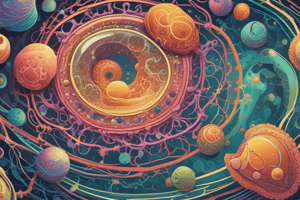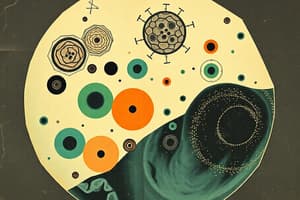Podcast
Questions and Answers
What are the four broad categories of cells in the human body?
What are the four broad categories of cells in the human body?
Epithelial cells, connective tissue cells, nerve cells, muscle cells
What is the primary function of the nucleus?
What is the primary function of the nucleus?
- Cellular signaling
- Energy production
- Protein synthesis
- Storage of genetic information (correct)
Ribosomes are surrounded by a membrane.
Ribosomes are surrounded by a membrane.
False (B)
What is the primary function of ribosomes?
What is the primary function of ribosomes?
Which type of endoplasmic reticulum contains ribosomes?
Which type of endoplasmic reticulum contains ribosomes?
What is the main role of the Golgi apparatus?
What is the main role of the Golgi apparatus?
What does the smooth endoplasmic reticulum store and release?
What does the smooth endoplasmic reticulum store and release?
The ________ is approximately the largest organelle in a cell.
The ________ is approximately the largest organelle in a cell.
What are the four broad categories of cells in the human body?
What are the four broad categories of cells in the human body?
Which of the following is NOT a type of cellular organelle?
Which of the following is NOT a type of cellular organelle?
The nucleus is the smallest organelle in a cell.
The nucleus is the smallest organelle in a cell.
What is the primary function of ribosomes?
What is the primary function of ribosomes?
The structure of the Golgi apparatus is a series of membranous sacs called ______.
The structure of the Golgi apparatus is a series of membranous sacs called ______.
Which organelle is known as the cellular 'post office'?
Which organelle is known as the cellular 'post office'?
What does the rough endoplasmic reticulum primarily synthesize?
What does the rough endoplasmic reticulum primarily synthesize?
Flashcards are hidden until you start studying
Study Notes
Cells are the Basic Building Blocks of Life
- The human body is composed of approximately 200 distinct cell types.
- There are four main categories of cells: epithelial, connective tissue, nerve, and muscle cells.
- This lecture focuses on the physiology of "generic" cells, those fundamental structures that make up all tissues and organs.
Cells are Complex Structures with Specialized Organelles
- Cells are enclosed by membranes and contain specialized structures called organelles.
- Organelles are responsible for distinct functions within the cell.
The Nucleus: The Cell's Control Center
- The nucleus is the largest organelle, typically present as one per cell.
- It is the primary location for storing genetic information in the form of DNA, organized as chromatin.
- The nucleus is surrounded by a double membrane called the nuclear envelope, which contains openings called nuclear pores.
- Nuclear pores allow for the passage of RNA into the cytoplasm and the entrance of proteins that regulate gene expression.
- The nucleus also contains a nucleolus, the site of ribosomal RNA synthesis and protein assembly for ribosomes.
Ribosomes: The Protein Factories
- Ribosomes are the smallest and most abundant organelles, approximately 10 million per cell.
- They are responsible for protein synthesis, translating RNA into protein.
- Ribosomes are not bound by a membrane but are composed of proteins and RNA.
- They are central to the central dogma of molecular biology (Watson & Crick): DNA -> RNA -> protein.
- Ribosomes can be found free-floating in the cytoplasm or attached to the endoplasmic reticulum.
- Free ribosomes primarily synthesize proteins that remain within the cytoplasm.
- Membrane-bound ribosomes primarily synthesize membrane-bound proteins.
The Endoplasmic Reticulum: A Network for Protein Synthesis and Other Functions
- The endoplasmic reticulum (ER) is a network of membrane-enclosed spaces distributed throughout the cell.
- There are two forms of ER: smooth and rough.
- The smooth ER (SER) is continuous with the rough ER and the nuclear envelope. It contains enzymes for functions such as lipid synthesis and serves as a calcium storage and release site.
- The rough ER (RER) appears rough due to attached ribosomes. It serves as a site for protein synthesis, and the proteins synthesized in its lumen are distributed to other organelles or secreted from the cell.
The Golgi Apparatus: The Cell's Sorting and Packaging Center
- The Golgi apparatus is a series of flattened membranous sacs called cisternae, forming a cup shape.
- It is characterized by a cis face and a trans face, with a distinct polarity.
- The Golgi apparatus serves as the cell's "post office," modifying and sorting proteins arriving from the rough ER.
- It distributes these proteins to other organelles or to the membrane for secretion.
Cellular Physiology
- The human body is made up of approximately 200 distinct cell types
- There are four broad categories of cells: epithelial cells, connective tissue cells, nerve cells and muscle cells
- Cells are surrounded by membranes and contain specialized structures called organelles.
- Organelles perform specific tasks within the cell, enabling it to function as a whole.
Cellular Organelles
- The nucleus is the largest organelle in a cell and is responsible for storing genetic information (DNA) in the form of chromatin.
- The nucleus is surrounded by the nuclear envelope, which has openings called nuclear pores that allow for the passage of RNA into the cytoplasm and the entrance of proteins that regulate gene expression.
- The nucleolus is a structure within the nucleus where ribosomal RNA (rRNA) synthesis and the protein components of ribosomes are produced.
- Ribosomes are the smallest and most abundant organelle within the cell, responsible for protein synthesis.
- Ribosomes are composed of proteins and RNA and are found either free-floating in the cytoplasm or attached to the endoplasmic reticulum (ER).
- Free ribosomes typically synthesize proteins that remain within the cytoplasm, while membrane-bound ribosomes synthesize proteins that are destined for the membrane or other organelles
- The ER is an extensive network of membrane-enclosed compartments that extends throughout the cell.
- The ER exists in two forms: rough endoplasmic reticulum (RER) and smooth endoplasmic reticulum (SER).
- The RER, which has a rough appearance due to the attached ribosomes, is the site of protein synthesis. Proteins synthesized in the RER lumen can be distributed to other organelles or secreted from the cell.
- The SER is continuous with both the RER and the nuclear envelope, containing enzymes involved in various metabolic processes, such as fatty acid synthesis, and is also involved in calcium storage and release.
- The Golgi apparatus is a series of membranous sacs called cisternae, arranged in a cup-like structure.
- The Golgi apparatus has two distinct faces: a cis face and a trans face.
- The Golgi apparatus functions as the cell's "post office," modifying and sorting proteins arriving from the RER and then distributing them to other organelles or to the membrane for secretion.
Studying That Suits You
Use AI to generate personalized quizzes and flashcards to suit your learning preferences.




